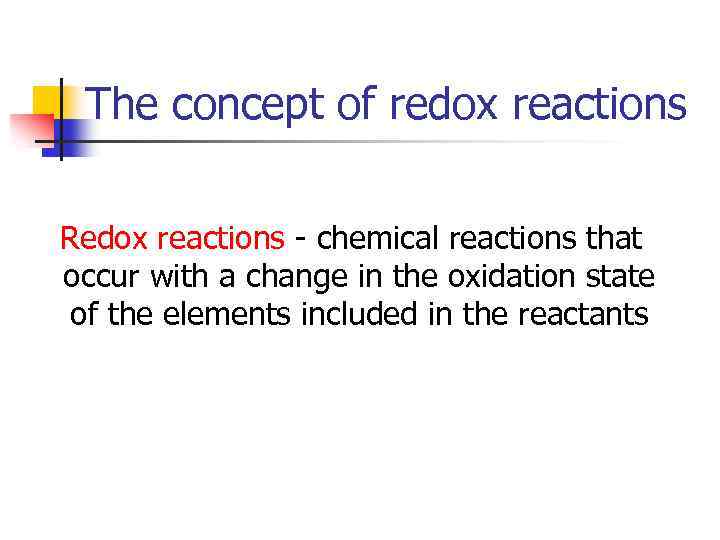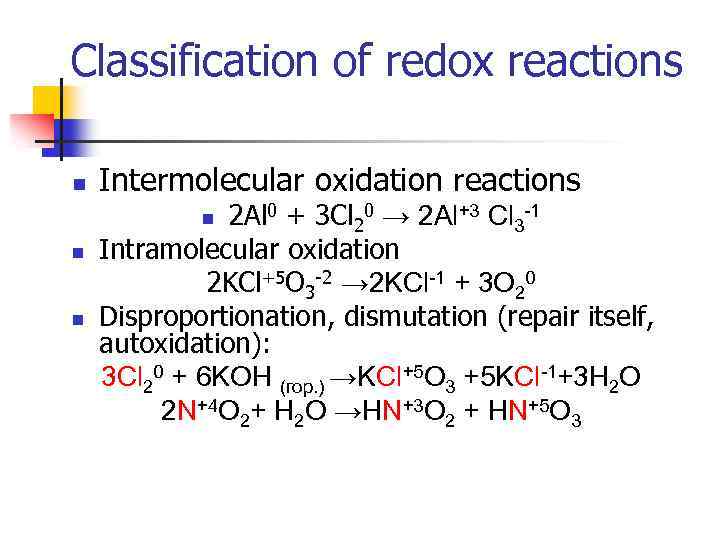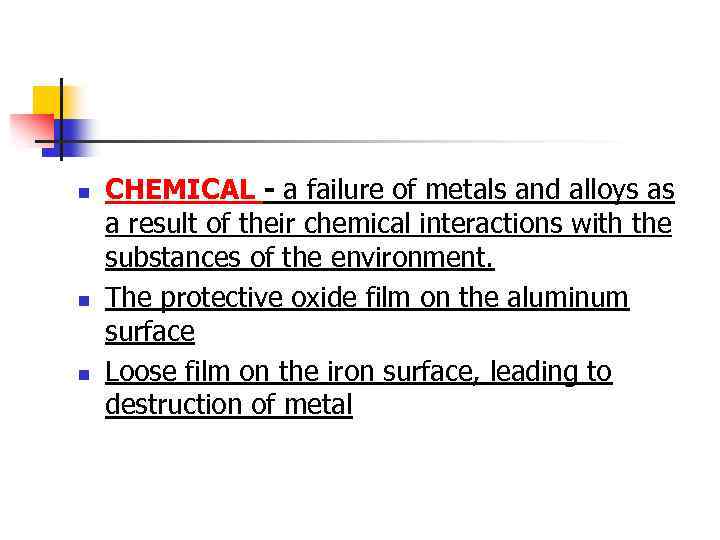6лекция.ppt
- Количество слайдов: 20
 Redox reactions
Redox reactions
 The concept of redox reactions Redox reactions - chemical reactions that occur with a change in the oxidation state of the elements included in the reactants
The concept of redox reactions Redox reactions - chemical reactions that occur with a change in the oxidation state of the elements included in the reactants
 Oxidation - the process of recoil electrons an atom, molecule or ion. n n Atoms are converted into positively charged ion: Zn 0 – 2 e → Zn 2+ negatively charged ion becomes neutral atom: 2 Cl- -2 e →Cl 20 S 2 - -2 e →S 0 n The value of the positively charged ion (an atom) is increased accordingly the number of electron donating: Fe 2+ -1 e →Fe 3+ Mn+2 -2 e →Mn+4
Oxidation - the process of recoil electrons an atom, molecule or ion. n n Atoms are converted into positively charged ion: Zn 0 – 2 e → Zn 2+ negatively charged ion becomes neutral atom: 2 Cl- -2 e →Cl 20 S 2 - -2 e →S 0 n The value of the positively charged ion (an atom) is increased accordingly the number of electron donating: Fe 2+ -1 e →Fe 3+ Mn+2 -2 e →Mn+4
 Recovery - the process of accession of electrons an atom, molecule or ion. n n Atom converted to a negatively charged ion S 0 + 2 e → S 2− Br 0 + e → Br − The value of the positively charged ions (atoms) reduced by the number of electrons attached: Mn+7 + 5 e → Mn+2 S+6 + 2 e → S+4 − or it can go into a neutral atom: Н+ + е → Н 0 Cu 2+ + 2 e → Cu 0
Recovery - the process of accession of electrons an atom, molecule or ion. n n Atom converted to a negatively charged ion S 0 + 2 e → S 2− Br 0 + e → Br − The value of the positively charged ions (atoms) reduced by the number of electrons attached: Mn+7 + 5 e → Mn+2 S+6 + 2 e → S+4 − or it can go into a neutral atom: Н+ + е → Н 0 Cu 2+ + 2 e → Cu 0
 Recovery - atoms, molecules, or ions donate electrons. They are in the process redox reaction oxidized Typical reductants: ● metal atoms with high atomic radii (I-A, II-A group), as well as Fe, Al, Zn ● simple substances, non-metals: hydrogen, carbon, boron; ● negative ions: Cl−, Br−, I−, S 2−, N− 3. We are reducing the fluoride ion F−. ● metal ions in lower oxidation states: Fe 2+, Cu+, Mn 2+, Cr 3+; ● complex ions and molecules containing atoms with intermediate oxidation state: SO 32−, NO 2−; СО, Mn. O 2 and others.
Recovery - atoms, molecules, or ions donate electrons. They are in the process redox reaction oxidized Typical reductants: ● metal atoms with high atomic radii (I-A, II-A group), as well as Fe, Al, Zn ● simple substances, non-metals: hydrogen, carbon, boron; ● negative ions: Cl−, Br−, I−, S 2−, N− 3. We are reducing the fluoride ion F−. ● metal ions in lower oxidation states: Fe 2+, Cu+, Mn 2+, Cr 3+; ● complex ions and molecules containing atoms with intermediate oxidation state: SO 32−, NO 2−; СО, Mn. O 2 and others.
 Oxidants - atoms, molecules or ions, electrons join. They are in the process of oxidation-reduction reactions are restored Typical oxidizers: ● nonmetal atoms VII-A, VA group consisting of simple substances ● metal ions in the higher oxidation state: Cu 2+, Fe 3+, Ag+ … ● Complex ions and molecules containing atoms with the highest and lowest oxidation state: с. о. : SO 42−, NO 3−, Mn. O 4−, Сl. О 3−, Cr 2 O 72 -, SO 3, Mn. O 2 and others
Oxidants - atoms, molecules or ions, electrons join. They are in the process of oxidation-reduction reactions are restored Typical oxidizers: ● nonmetal atoms VII-A, VA group consisting of simple substances ● metal ions in the higher oxidation state: Cu 2+, Fe 3+, Ag+ … ● Complex ions and molecules containing atoms with the highest and lowest oxidation state: с. о. : SO 42−, NO 3−, Mn. O 4−, Сl. О 3−, Cr 2 O 72 -, SO 3, Mn. O 2 and others
 n On the display of the redox properties of the effect of such factors as the stability of the molecule or ion. The stronger the particle, the less it shows the redox properties
n On the display of the redox properties of the effect of such factors as the stability of the molecule or ion. The stronger the particle, the less it shows the redox properties
 The degree of oxidation of sulfur: -2, 0, +4, +6 n n n Н 2 S-2 - reductant 2 Н 2 S+3 O 2=2 H 2 O+2 SO 2 S 0, S+4 O 2 – oxidant and reductant S+O 2=SO 2 2 SO 2+O 2=2 SO 3 (reductant) S+2 Na=Na 2 S SO 2+2 H 2 S=3 S+2 H 2 O (oxidant) n n Н 2 S+6 O 4 - oxidant Cu+2 H 2 SO 4=Cu. SO 4+SO 2+2 H 2 O
The degree of oxidation of sulfur: -2, 0, +4, +6 n n n Н 2 S-2 - reductant 2 Н 2 S+3 O 2=2 H 2 O+2 SO 2 S 0, S+4 O 2 – oxidant and reductant S+O 2=SO 2 2 SO 2+O 2=2 SO 3 (reductant) S+2 Na=Na 2 S SO 2+2 H 2 S=3 S+2 H 2 O (oxidant) n n Н 2 S+6 O 4 - oxidant Cu+2 H 2 SO 4=Cu. SO 4+SO 2+2 H 2 O
 Определение степеней окисления атомов химических элементов n n n The oxidation state of atoms of chemical elements in the simple substance = 0 The algebraic sum of oxidation states of all elements in the ion is the ion charge The algebraic sum of oxidation states of all elements in the composite material is 0. K+1 Mn+7 O 4 -2 1+х+4(-2)=0
Определение степеней окисления атомов химических элементов n n n The oxidation state of atoms of chemical elements in the simple substance = 0 The algebraic sum of oxidation states of all elements in the ion is the ion charge The algebraic sum of oxidation states of all elements in the composite material is 0. K+1 Mn+7 O 4 -2 1+х+4(-2)=0
 Classification of redox reactions n Intermolecular oxidation reactions 2 Al 0 + 3 Cl 20 → 2 Al+3 Cl 3 -1 Intramolecular oxidation 2 KCl+5 O 3 -2 → 2 KCl-1 + 3 O 20 Disproportionation, dismutation (repair itself, autoxidation): 3 Cl 20 + 6 KOH (гор. ) →KCl+5 O 3 +5 KCl-1+3 H 2 O 2 N+4 O 2+ H 2 O →HN+3 O 2 + HN+5 O 3 n n n
Classification of redox reactions n Intermolecular oxidation reactions 2 Al 0 + 3 Cl 20 → 2 Al+3 Cl 3 -1 Intramolecular oxidation 2 KCl+5 O 3 -2 → 2 KCl-1 + 3 O 20 Disproportionation, dismutation (repair itself, autoxidation): 3 Cl 20 + 6 KOH (гор. ) →KCl+5 O 3 +5 KCl-1+3 H 2 O 2 N+4 O 2+ H 2 O →HN+3 O 2 + HN+5 O 3 n n n
 The value of redox reactions n n n Redox reactions are very common. They linked the metabolic processes in living organisms, respiration, rotting, fermentation, photosynthesis. Redox reactions provide the cycling of matter in nature. They can be seen from the combustion and smelting of metal corrosion. With their help prepared alkalis, acids and other valuable chemicals. Redox reactions underlie energy conversion interacting chemicals in eclectic energy in the battery cell.
The value of redox reactions n n n Redox reactions are very common. They linked the metabolic processes in living organisms, respiration, rotting, fermentation, photosynthesis. Redox reactions provide the cycling of matter in nature. They can be seen from the combustion and smelting of metal corrosion. With their help prepared alkalis, acids and other valuable chemicals. Redox reactions underlie energy conversion interacting chemicals in eclectic energy in the battery cell.
 Corrosion of metals Methods corrosion protection
Corrosion of metals Methods corrosion protection
 n n n CORROSION - spontaneous destruction of metals and alloys as a result of chemical and electrochemical interactions with their environment. This redox reaction in which the metal atoms become ions. The more active the metal, so it is more susceptible to corrosion. In the role of an oxidant act atmospheric oxygen and hydrogen cations.
n n n CORROSION - spontaneous destruction of metals and alloys as a result of chemical and electrochemical interactions with their environment. This redox reaction in which the metal atoms become ions. The more active the metal, so it is more susceptible to corrosion. In the role of an oxidant act atmospheric oxygen and hydrogen cations.
 Factors that may cause corrosion 1. 2. 3. 4. Oxygen and atmospheric moisture Carbon and sulfur gases contained in the atmosphere Sea water Groundwater
Factors that may cause corrosion 1. 2. 3. 4. Oxygen and atmospheric moisture Carbon and sulfur gases contained in the atmosphere Sea water Groundwater
 Corrosion metals By type corrosion environments By processes By character failure chemical is uniform electroche mical nonuniform (or local election) gas atmospheric soil liquid (acid, salt, alkali)
Corrosion metals By type corrosion environments By processes By character failure chemical is uniform electroche mical nonuniform (or local election) gas atmospheric soil liquid (acid, salt, alkali)
 n n n CHEMICAL - a failure of metals and alloys as a result of their chemical interactions with the substances of the environment. The protective oxide film on the aluminum surface Loose film on the iron surface, leading to destruction of metal
n n n CHEMICAL - a failure of metals and alloys as a result of their chemical interactions with the substances of the environment. The protective oxide film on the aluminum surface Loose film on the iron surface, leading to destruction of metal
 n n n Electrochemical - a failure of metals, which is accompanied by the appearance of an electric current in water or another electrolyte medium. Chemical processes - this oxidation metal recoil electrons. Electrical processes - transfer of electrons from one site to another product.
n n n Electrochemical - a failure of metals, which is accompanied by the appearance of an electric current in water or another electrolyte medium. Chemical processes - this oxidation metal recoil electrons. Electrical processes - transfer of electrons from one site to another product.
 CONDITIONS of electrochemical corrosion 1. 2. 3. 4. 5. The position of the metal in a series of activity of metal: the farther they are from each other, the faster corrosion. The purity of the metal: the impurity accelerate corrosion. Irregularities in the metal surface cracks. Ground water, sea water, the environment of the electrolyte. Temperature increase. The action of microorganisms (fungi, bacteria, lichens to metals with high corrosion resistance).
CONDITIONS of electrochemical corrosion 1. 2. 3. 4. 5. The position of the metal in a series of activity of metal: the farther they are from each other, the faster corrosion. The purity of the metal: the impurity accelerate corrosion. Irregularities in the metal surface cracks. Ground water, sea water, the environment of the electrolyte. Temperature increase. The action of microorganisms (fungi, bacteria, lichens to metals with high corrosion resistance).
 METHODS corrosion protection 1. 2. 3. 4. The application of protective coatings (paints, varnishes, enamels); Covering other metals (gold-plated, silver, chrome, zinc plating); Creation and use of corrosionresistant alloys Introduction to the inhibitors reduce aggressive environment; Sacrificial protection
METHODS corrosion protection 1. 2. 3. 4. The application of protective coatings (paints, varnishes, enamels); Covering other metals (gold-plated, silver, chrome, zinc plating); Creation and use of corrosionresistant alloys Introduction to the inhibitors reduce aggressive environment; Sacrificial protection



